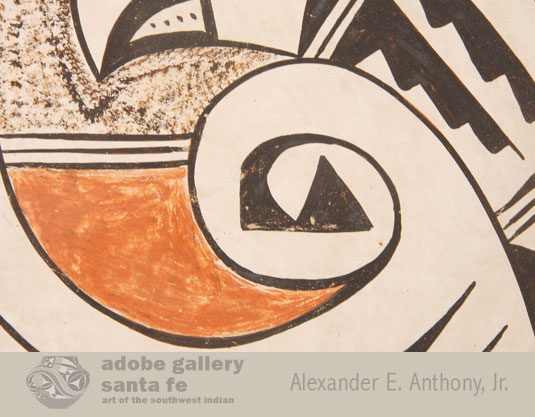Polychrome Hopi Pottery Plate with Spiral Bird Design by Evelyn Poolheco [SOLD]
+ Add to my watchlist Forward to Friend
- Category: Modern
- Origin: Hopi Pueblo, Hopituh Shi-nu-mu
- Medium: clay, pigment
- Size: 11-½” diameter x 1” depth
- Item # C4052E SOLD
One potter who used the Sikyatki designs in her pottery was Evelyn Poolheco from the First Mesa Tewa Village at Hopi. She was a Hopi-Tewa of the Spider Clan and is reported as having been an active potter between 1960 and 1980. She specialized in black-on-yellow and black-on-red pottery, and her favorite design was that of the stylized Sikyatki parrot.
 This interesting plate features black and red curvilinear feather designs that adhere to the circular shape of the plate. The artist incorporated geometric patterns within the parrot designs, reflecting the continued use of traditional Sikyatki designs into her work. It is signed clearly on the back of the plate by the artist. The potter created two holes at the edge of the plate and inserted a cord so that the plate could be displayed by hanging.
This interesting plate features black and red curvilinear feather designs that adhere to the circular shape of the plate. The artist incorporated geometric patterns within the parrot designs, reflecting the continued use of traditional Sikyatki designs into her work. It is signed clearly on the back of the plate by the artist. The potter created two holes at the edge of the plate and inserted a cord so that the plate could be displayed by hanging.
In the late 19th Century, Jesse Walter Fewkes led the Hemenway Expedition to the American Southwest to do anthropological studies of the Hopi and Zuni tribes. While there, he undertook the excavation of the ancient Hopi village of Sikyatki where he found a large number of ceramic wares. Sikyatki Polychrome was produced from about AD 1375 to AD 1625. Fewkes worked with potters on First Mesa to catalog the designs and record them. At that time there was a revival of using Sikyatki designs on Hopi pottery. The best-known potter who began to utilize the ancient designs was Nampeyo of Hano, but many other potters also began to incorporate the curvilinear bird and feather designs into their pottery. The revival of Sikyatki designs on Hopi pottery continues to this day.
The Hopi have lived on three mesas in northeastern Arizona for more than 1,000 years. Today they live in 12 separate villages on or below the three Mesas. The Hopi language is part of the Uto-Aztecan language group, one of the largest Native American language groups. Tribes speaking Uto-Aztecan languages range geographically from the Shoshone of northern Idaho to the Pipil of El Salvador. On Hopi’s First Mesa, a group of relative newcomers from the Rio Grande Tewa Pueblos speak the Tewa language.
Condition: The Polychrome Hopi Pottery Plate with Spiral Bird Design by Evelyn Poolheco is in very good condition. There are no cracks or chips.
Provenance: from a resident of Iowa, whose mother collected this and other pueblo pottery, who has inherited her mother’s estate and is not comfortable having breakable art around her operating ranch.
Recommended Reading: Contemporary Hopi Pottery by Laura Graves Allen
Relative Links: Zuni Pueblo, Shoshone, Jesse Walter Fewkes, Evelyn Poolheco, Southwest Indian Pottery, Contemporary Pottery, Rachel Namingha Nampeyo, Hopi Pueblo, Nampeyo of Hano, Annie Healing, Priscilla Nampeyo, Dextra Nampeyo

- Category: Modern
- Origin: Hopi Pueblo, Hopituh Shi-nu-mu
- Medium: clay, pigment
- Size: 11-½” diameter x 1” depth
- Item # C4052E SOLD



